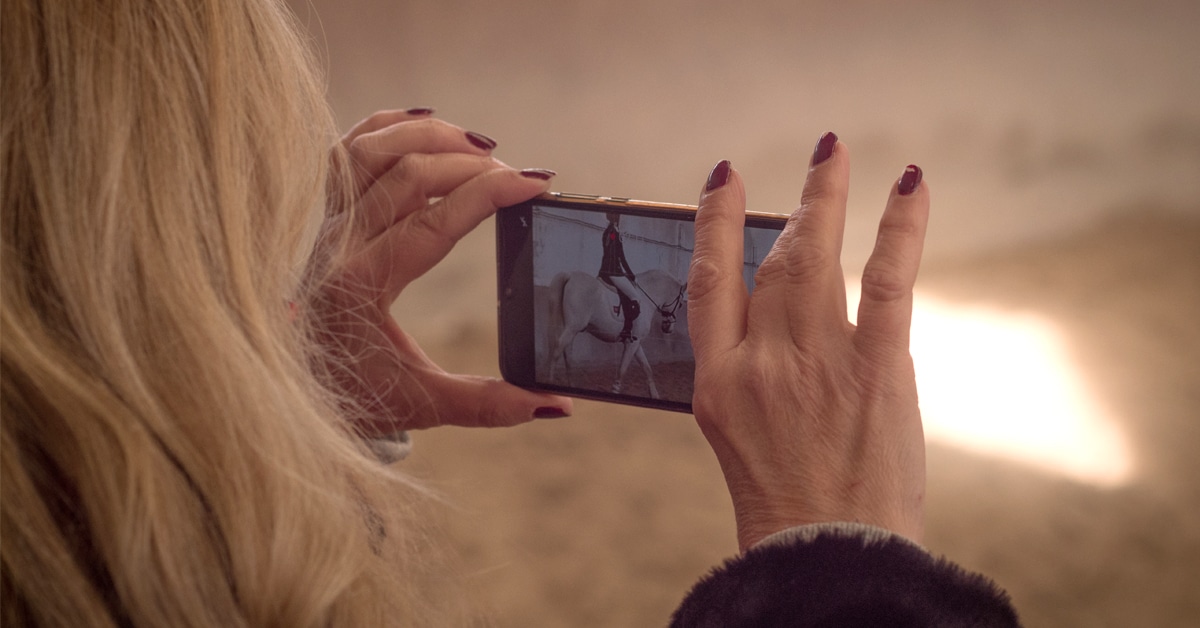The FEI has urged people to feel free to film alleged welfare violations at shows in a rearguard action to persuade the community that its updated copyright guidelines for “FEI-named events” are not censorship.
This and other clarifications were included in a Q&A belatedly posted on the FEI website on March 8 following a stormy few days on social media. Welfare campaigners were worried about the facility to monitor potential offenders in future, while riders and spectators angrily assumed they could no longer share their own rides on personal social platforms.
The FEI has been at pains to emphasise it is not curtailing filming of the “field of play” as such; the issue is solely over the sharing of a limited amount of video from less than 5% of FEI shows and events on personal social media and websites. It states: “These guidelines are in no way an attempt to censor anyone or prohibit transparency at events; they are in place to ensure the rights of Rights Holding Broadcasters at FEI-Named-Events are fully respected. For complete transparency, the events are streamed live and in their entirety on FEI TV and/or the FEI YouTube channel, and are also available to watch afterwards.
“If someone sees behaviour they have a concern about while on-site at any FEI Event, including the FEI Named Events, there is no issue with the person filming the behaviour in question. We strongly encourage anyone who has observed concerning behaviour to report it by sharing the footage directly with the FEI for follow up.”
Outrage was especially strong in the dressage community, which assumed the policy was a brazen attempt to stop circulation of video evidence in the wake of the Helgstrand and Parra scandals. Only days earlier, rights holder ClipMyHorse had demanded that a well-followed Instagram page, BlondeDressage, remove the many edited clips it shares of hyperflexion (though supporters soon came up with legal ways around the issue.)
Restrictions on how non-rights holders (i.e. riders, their connections and the general public) can re-purpose copyrighted content have been in place for five years. But it seems they were barely noticed by the wider community – or enforced – until a scheduled update on February 12 (which made a change affecting Instagram) was spotted by respected Swedish publication, Ridsport. Ridsport flagged them up two weeks later under a headline which translated into English on Google as “FEI bans filming at major competitions,” and quickly went viral.
The confusion was compounded by many posters not understanding what is meant by a FEI-named event, or conflating the video usage guidelines with an older Q&A about the separate policy for FEI registered riders and officials on safeguarding and publishing defamatory or bullying remarks on social media. Other posts became “lost in translation” through being run through several different languages on Google Translate.
For several days, veteran photographers and journalists used to working with broadcast and media “rights” tried in vain to explain.
The FEI, like all sports governing bodies, has a contractual obligation to protect the “exclusivity” of third party broadcasters who have bought the filming rights to a handful of FEI-named events. These events are:
- Longines League of Nations™ ( now encompassing fewer shows than last year due to its new format)
- Longines FEI Jumping World Cup™ – Western European League and North American League
- FEI Dressage World Cup™ – Western European League
- FEI Driving World Cup™
- FEI Vaulting World Cup™ Final
- FEI Eventing Nations Cup™ (eight events in Europe, no round yet designated in north America.)
- FEI Championships for Seniors (European Championships, World Championships) – none taking place in 2024 in jumping, dressage and eventing due to the Olympic Games which is governed by its own broadcast rights that are nothing to do with the FEI.
At World Cup qualifying shows, the supporting classes are also not impacted by these guidelines. Examples of big-ticket events that are not “FEI-named events” and so not restricted by this policy include all jumping at Spruce Meadows (including its stand-alone Nations Cup), the Global Champions Tour and League, Aachen and the 5* horse trials at Kentucky, Maryland, Badminton and Burghley.
The Pan Am Games are also not bound by the FEI restriction, though its organisers are free to apply their own and have indeed done so in the past.
What you cannot do if you are a “non-rights holding” rider, groom, spectator, journalist, influencer, team manager and even representative of a national federation:
- Share your own videos taken on smart phones or any other device at FEI-named events on social media or any other personal platform
- Copy or take extracts from official broadcasts from FEI-named events for the purpose of sharing them on social media
- Re-transmit an official broadcast from a FEI-named event on a livestream, ie Facebook Live
What you can do:
- Film and share footage from all other non-named events, i.e. 95% of the FEI calendar, from your own smartphone or other device
- Share your own still photography from any show or event including named events on your social platforms
- Share footage from both named and all other shows and events direct from the FEI’s own social channels
- At an FEI-named event, film your own ride and warm-for personal use, ie discussing with your trainer afterwards, as long as it is not shared on social platforms
- If you are an athlete at an FEI-named event, obtain footage of your ride from FEI Soclalie for authorised use on your social platforms
- Apply for additional competition footage for editorial or commercial purposes by becoming a Rights Holder for the named event (contact broadcast@fei.org.)
- Film anything of concern, i.e. welfare violations, anywhere at any time and send it to the FEI.
The “field of play” at named-events encompasses the main arena, warm-up, Kiss & Cry Zone, Leaders lounge, entrance/exit area, eventing cross-country and driving marathon.

